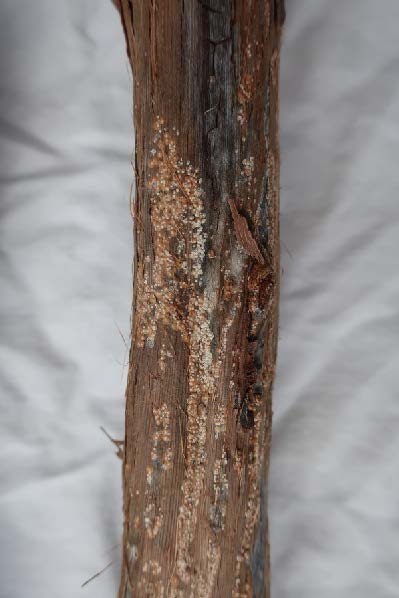Vinews
No. 7 — June 13, 2022
Contents:
Grape Scale Diaspidiotus Uvae: An Inconspicuous Grape Pest

Unlike many other insect pests that we readily see in the vineyard, the grape scale remains mainly hidden out of sight. The hidden nature of the pest can result in the populations building up over time, but even these population increases remain hidden. Sometimes your first clue that scale insects are becoming a problem is when you see vine decline. Scale insects, of which there are over 8,000 species worldwide, belong to the order Hemiptera or true bugs that have piercing sucking mouthparts. Another grape pest, the grape mealybug Pseudococcus maritimus also belongs to the order Hemiptera.
Grape scales are not readily seen in the vineyard since most of their lifecycle takes place under the grapevine bark. When scouting for grape scale the bark on the trunk, cordon or spur needs to be peeled away (Figure 1). Initially, focus your scouting efforts on grapevines showing signs of decline. Remove bark from the base of the trunk and work your way up to the cordons. If scale insects are not found on the trunk, grape scale will seldom be found on the cordon and spurs based on my experience.
The grape scale overwinters under the bark as a mated female and as spring arrives the scale resumes growth and development. The crawler stage is the mobile stage of development and occurs in May and June. The crawlers are mobile a short period of time (less than 48 hours) before feeding and starting the process of secreting the scale covering. Females never move from their feeding site whereas winged males emerge in the spring and summer to mate with females. Seldom are winged males seen since the flight duration is short lived. This is very similar to male mealybug flight duration.
Grape scale can be very destructive if populations increase over time. If scouting results in turning up grape scale then a management plan should be started.
Prior to bud break, apply Superior oil to grapevine trunks and cordons. When applying Superior oil, be sure to saturate the trunk and cordons. This will result in the spray mixture running into voids and crevices under the bark where the grape scales reside. Superior oil spray solution must come in contact with the grape scale to be effective. All dormant oils cause lethality by depriving the insect pest of oxygen and by disrupting cellular membranes. Dormant oil sprays help preserve many of the beneficial insects since the application timing is prior to many of the beneficial insects emergence.
Carbaryl can be applied to target crawlers. The first generation crawler or spring generation begins to emerge at 274 degree days (DD) (base 50 F) with peak crawler emergence at 356 DD (base 50 F) with DD being accumulated from April 1. The second generation crawler or Summer generation begins to emerge at 1166 DD (base 50 F) with peak crawler emergence at 1541 DD (base 50 F) with DD being accumulated from April 1. Besides monitoring degree days, apply double sided tape around trunks of grapevines that have known grape scale to monitor for crawlers.
By using the DD above and historical temperature data from (1981-2010) for Boone County, MO, the approximate calendar dates for crawler emergence and peak crawler emergence can be estimated. The spring crawler emergence begins around May 1 and peaks on May 9. The Summer crawler emergence begins on June 22 and peaks on July 8. These dates are specific to Boone County and your location will be different. This type of information provides us a window of when we can expect the spring and summer crawler generations to appear.
Lorsban Advanced and generics containing the active ingredient chlorpyrifos was the standard insecticide for the control of grape scale. Lorsban Advanced or generics containing the active ingredient chlorpyrifos can no longer be used in food crops in 2022 and beyond. On August 18, 2021, the EPA announced it was banning chlorpyrifos applications on all food crops.
topHigh Temperatures and Phytotoxicity
- Common fungicides such as copper products, sulfur products, and captan can cause phytotoxicity, but seldom will they cause phytotoxicity by themselves
- Oils, adjuvants, stickers can enhance penetration of the pesticide through the cuticle. Urea applied as a foliar spray enhances pesticide penetration
- High humidity conditions slow pesticide dry time and may enhance penetration
- Temperatures over 90° F and sulfur applications can result in phytotoxicity especially at high relative humidity that decrease drying time
- Captan can become phytotoxic at high temperatures. Avoid spraying when temperatures are above 85° F
- Adjuvants can heat up the spray mixture — be especially careful with your spray cocktail during high temperatures
Please scout your vineyards on a regularly scheduled basis in an effort to manage problem pests. This report contains information on scouting reports from specific locations and may not reflect pest problems in your vineyard. If you would like more information on IPM in grapes, please contact Dean Volenberg at 573-882-0476 or 573-473-0374 (mobile) or volenbergd@missouri.edu